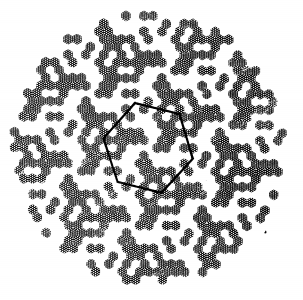Primes & Hexagonal uniformly redundant array
Watch the YouTube video Coded Mask - Sixty Symbols and
have a look at this published paper: Hexagonal Uniformly Redundant Arrays for Coded-Aperture Imaging.
Question: Mathematically how is it possible to use such patterns to uniquely identify the source of light? How selecting the prime number order helps in this process?

No vote yet
1 vote
Easy Math Editor
This discussion board is a place to discuss our Daily Challenges and the math and science related to those challenges. Explanations are more than just a solution — they should explain the steps and thinking strategies that you used to obtain the solution. Comments should further the discussion of math and science.
When posting on Brilliant:
*italics*or_italics_**bold**or__bold__paragraph 1
paragraph 2
[example link](https://brilliant.org)> This is a quote# I indented these lines # 4 spaces, and now they show # up as a code block. print "hello world"\(...\)or\[...\]to ensure proper formatting.2 \times 32^{34}a_{i-1}\frac{2}{3}\sqrt{2}\sum_{i=1}^3\sin \theta\boxed{123}Comments
This is an interesting subject. Unfortunately, I'm not versed enough in group theory to be able to fully answer your question, but for those unfamiliar with this technique the basic concept is that if any number of the same mask of this type is overlapped and added together, it will always be possible to uniquely "undo" the summation. Let's say an 1D aperture mask has the function M(x). Then such a sum would be ∑kakM(x+bk), where a is an arbitrary coefficient representing the luminosity of a source in a particular direction, and b is the offset representing that direction. Given this sum, can it be "unpacked" to determine the unique a,b of each source? For most arbitrary aperture masks, it cannot be, but for these "uniformly redundant arrays", taking advantage of certain mathematical properties, it can always be uniquely unpacked. For practical use, the aperture mask is a 2D function M(x,y), and many such arrays are possible with this mathematical property.
Here's an introductory text on this subject by NASA
Coded aperture camera imaging concept
Log in to reply
Thanks Scythian, that link was helpful, the intriguing question is that why a prime number order has the property to uniquely identify all the sources. I have also gone through the mark generation algorithm as given in that paper which I had shared, but I am confused about references of primes of form 4n-1 and 12n+7. why only those particular form of primes work, is beyond me. Opps I just realized that I am still used to your screen name from Y!A , I hope that's fine with you :)
Log in to reply
That's okay referring to me as "Scythian", since that's almost become my 2nd name, having had that since the 1990s. But this subject deeply involves group theory, and groups themselves deeply involve prime numbers. That is, there is a close connection between the two of them. For coded mask apertures, cyclic groups have the mathematical properties to make this work, and the construction of such cyclic groups is tied in with prime numbers. The actual cyclic group itself is not a property of number theory, so maybe that's where the confusion lies.
It might interest you that there are some parallels in cellular automata with this subject of "unpacking" optical information. That is to say, while most cellular automata algorithms do not allow "reconstruction of previous stages", some can be.
There's been an explosion in optical theory and image processing concurrent with the rise of computers in the 20th century, so it's been fascinating to see stuff like this come up. You know, along with things like phased array radars, radio telescope interferometry, thin-film optics, "lens-less" cameras, etc. I really appreciate your bringing attention to coded mask apertures, it seems to suggest possibilities.